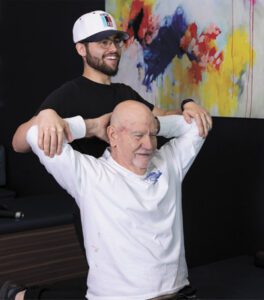By Angie Carlozzi, LMT, CMMP, CPMT – General Manager
 Parkinson’s disease is a progressive condition affecting the central nervous system, known for its impact on movement, balance, and coordination. While there is currently no cure, certain therapies are emerging as invaluable tools in improving quality of life. Among them, Proprioceptive Neuromuscular Facilitation (PNF) stretching stands out as a powerful technique for tackling movement-related challenges. Rooted in scientific research, PNF offers unique benefits that make it particularly effective for individuals with Parkinson’s.
Parkinson’s disease is a progressive condition affecting the central nervous system, known for its impact on movement, balance, and coordination. While there is currently no cure, certain therapies are emerging as invaluable tools in improving quality of life. Among them, Proprioceptive Neuromuscular Facilitation (PNF) stretching stands out as a powerful technique for tackling movement-related challenges. Rooted in scientific research, PNF offers unique benefits that make it particularly effective for individuals with Parkinson’s.
Understanding the Movement Challenges of Parkinson’s Disease
At its core, Parkinson’s disease disrupts the brain’s ability to control movement, manifesting as muscle rigidity, tremors, and slowed motion (bradykinesia). Over time, these symptoms can lead to pronounced stiffness, reducing range of motion and complicating daily activities. If left unchecked, muscle rigidity can cascade into decreased mobility and greater discomfort.
Therapeutic interventions such as PNF stretching have gained traction for their ability to address these challenges directly. By targeting both flexibility and muscle engagement, this technique helps pave the way to improved movement and comfort.
What Is PNF Stretching?
Proprioceptive Neuromuscular Facilitation is not your typical stretching technique. Unlike static stretches, where muscles are held in a prolonged position, or dynamic stretches, which involve movement, PNF blends muscle contraction with passive stretching. Guided by a trained professional, the method capitalizes on reflexes and muscle activation to enhance strength and flexibility. This active engagement makes PNF particularly effective for individuals navigating neurological conditions, including Parkinson’s.
What Does the Research Say?
A growing body of evidence underscores the benefits of PNF stretching for those living with Parkinson’s disease. For instance, a randomized controlled trial highlighted its ability to improve posture, specifically addressing forward head posture—a common issue in Parkinson’s patients. Participants in the study experienced improved flexibility and neuromuscular coordination, both critical for managing symptoms effectively.
Further studies reveal that PNF stretching positively influences balance and gait—two key aspects of functional mobility often impaired in Parkinson’s. By fostering stronger neuromuscular connections, PNF reduces the risk of falls and boosts overall stability.
Additionally, resources like the Stanford Parkinson’s Community Blog emphasize stretching as crucial for alleviating rigidity and enhancing joint function. PNF’s emphasis on both flexibility and strength aligns seamlessly with these objectives.
Key Benefits of PNF Stretching for Parkinson’s Disease
1. Reducing Muscle Stiffness: A hallmark symptom of Parkinson’s, rigidity is relieved through the active engagement and deep relaxation promoted by PNF.
2. Improving Range of Motion: Targeted techniques enable better mobility in joints and muscles most affected, such as the spine, shoulders, and hips.
3. Enhancing Balance and Gait: PNF stretching helps improve stability and walking ability, crucial for reducing fall risks and navigating daily life more safely.
4. Strengthening Weak Muscles: The inclusion of active engagement means PNF can strengthen areas weakened by inactivity or reduced motor function.
5. Promoting Neuromuscular Coordination: By bridging the gap between the nervous system and muscles, PNF fosters better motor control—a critical element for individuals with bradykinesia.
Incorporating PNF Stretching into a Parkinson’s Management Plan
For those considering PNF stretching as part of their therapeutic regimen, the following tips may help ensure a safe and effective experience:
• Work with Certified Professionals: PNF stretching requires expert guidance to be performed properly. Seek practitioners trained in both the technique and in working with individuals who have neurological conditions.
• Combine Therapies: Integrating PNF with physical therapy, occupational therapy, or exercise can amplify its benefits.
• Consistency Matters: Regular practice is vital for sustainable progress. Weekly or biweekly sessions often yield the best outcomes.
• Individualized Care: Share your limitations and goals with your practitioner, ensuring stretches are tailored to your comfort and needs.
Embracing a Holistic Approach to Parkinson’s Disease Management
Successfully managing Parkinson’s requires an integrated approach that encompasses physical, emotional, and neurological well-being. PNF stretching, with its scientifically-backed benefits for flexibility, strength, and mobility, is an excellent addition to this journey. While it’s not a cure, it empowers individuals to regain control over movement, offering a path to improved confidence and quality of life.
As with any therapeutic intervention, PNF stretching is most effective when approached with commitment and the guidance of skilled professionals. For those navigating the complexities of Parkinson’s, it represents a step toward a more mobile and empowered future.
Incorporating PNF Stretching into a Parkinson’s Management Plan
For those considering PNF stretching as part of their therapeutic regimen, the following tips may help ensure a safe and effective experience:
• Work with Certified Professionals: PNF stretching requires expert guidance to be performed properly. Seek practitioners trained in both the
technique and in working with individuals who have neurological conditions.
• Combine Therapies: Integrating PNF with physical therapy, occupational therapy, or exercise can amplify its benefits.
• Consistency Matters: Regular practice is vital for sustainable progress. Weekly or biweekly sessions often yield the best outcomes.
• Individualized Care: Share your limitations and goals with your practitioner, ensuring stretches are tailored to your comfort and needs.
Embracing a Holistic Approach to Parkinson’s Disease Management
Successfully managing Parkinson’s requires an integrated approach that encompasses physical, emotional, and neurological well-being. PNF stretching, with its scientifically-backed benefits for flexibility, strength, and mobility, is an excellent addition to this journey. While it’s not a cure, it empowers individuals to regain control over movement, offering a path to improved confidence and quality of life.
As with any therapeutic intervention, PNF stretching is most effective when approached with commitment and the guidance of skilled professionals. For those navigating the complexities of Parkinson’s, it represents a step toward a more mobile and empowered future.
352-221-9390
www.stretchlab.com
5814 Seven Mile Drive, Suite 103
Wildwood, FL 34785
 Central Florida Health and Wellness Magazine Health and Wellness Articles of the Villages
Central Florida Health and Wellness Magazine Health and Wellness Articles of the Villages



